History of the Church
St Barnabas’ Church celebrated its 50th anniversary in 2000. To mark the occasion, our vicar, the Revd George Day, prepared a history of the parish, of which this is an abridged version, with the ending updated to reflect the situation in 2005.
This history is the story of how the church has grown and developed over the years. It is a marvellous story of God’s faithfulness, and at the same time a story of the love, commitment, devotion and hard work of many people, clergy and lay. It is a story that deserves to be recorded, and we hope you find it interesting.
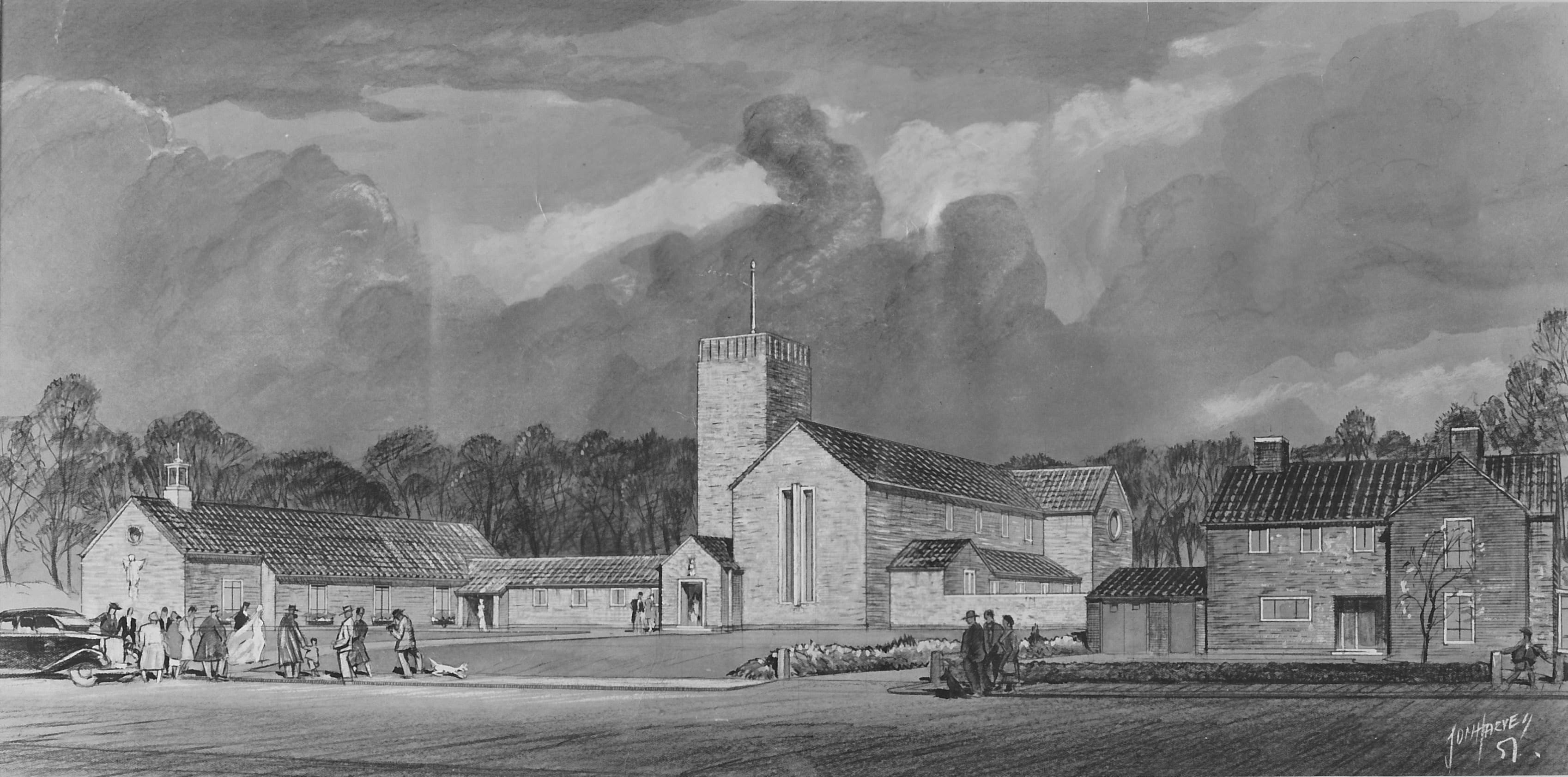
An early vision for a church at St Barnabas’, Cray: the church as finally built was rather less conservative!
Although the story of St Barnabas is a continuous whole, it is convenient to divide it into the periods covered by the different incumbents.
1949-1950: Getting it off the ground
Prior to the war, the area in which St Barnabas’ Church stands was mostly fields, orchards and woods. The western and eastern edges had been developed for housing, but in between lay a very large undeveloped area. In a period of about two years, starting in 1949, this changed dramatically: an estate of terraces, semi-detached houses, flats and maisonettes was built by London County Council.
The population was brought out from inner London – Camberwell, Bermondsey, etc. – a number of them with physical or mental health needs. When they arrived they found an area without shops, schools, churches, or any other community facilities. The Diocese of Rochester quickly realized the pressing need to provide a church, but also quickly became aware of what an enormous task that would be.
In August 1949 the Diocese of Rochester agreed to put in a Church Army Captain, Captain Leonard Goode, to work on the growing estate. It was also agreed that a site – the present site in Rushet Road – was to be purchased on which a Church Hall would be “erected immediately”. (Hindsight shows that with the size of the project, “immediately” was almost never an appropriate word!)
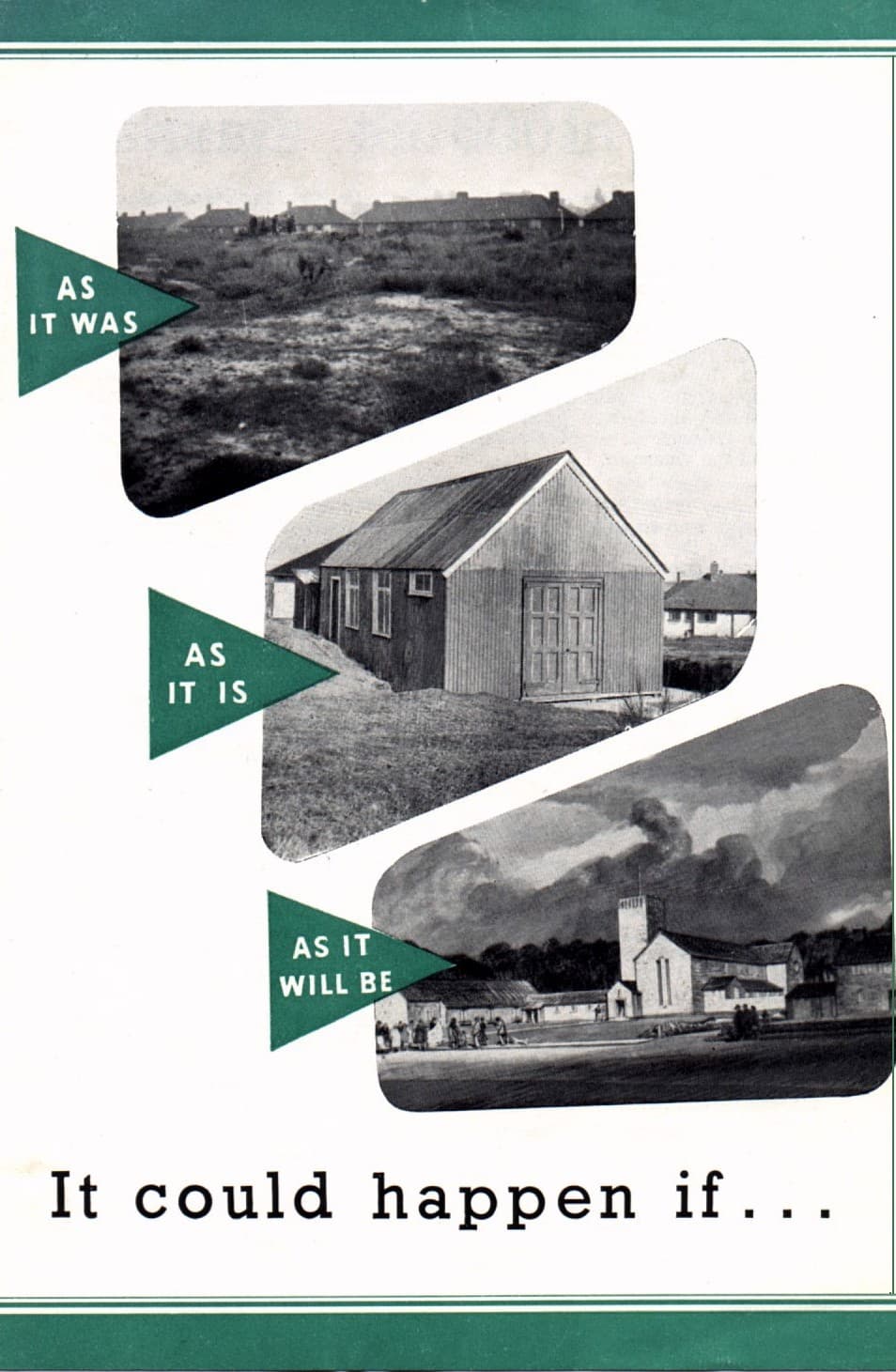
From waste ground to holy ground: the vision begins to unfold.
1950-1959: John Sertin and the vision of St Barnabas Builders
John Sertin came to the parish in July 1950, having served a curacy in Sidcup, and having just completed a degree at Cambridge. His own background was rather different to the majority of people on the estate, but he came with a real sense of vision for ministry in a housing area such as St Paul’s Cray.
A few months after his arrival, in October, the area was designated the “Conventional District of St Barnabas Cray in the Parishes of Chislehurst, St. Paul’s Cray and St. Mary Cray”. The hope was to build a church, and once that was built the area could become a parish.
The Rochester Diocesan Evangelical Union (RDEU), taking up an idea originally suggested by John Sertin, agreed with the diocese that if the RDEU raised money for a church then the diocese would give the patronage to CPAS (Church Pastoral Aid Society), so as to ensure the ministry would always be evangelical.
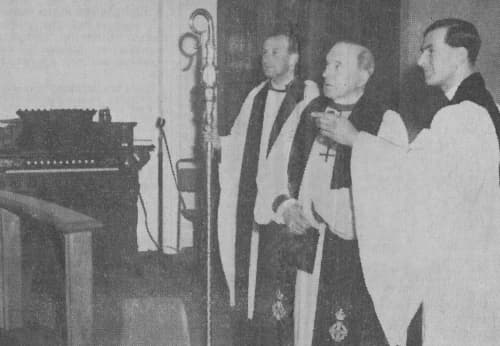
John Sertin (right) with the Bishop of Rochester (centre) at the dedication of the hall church, Friday 11th June, 1954
So in November 1951, St Barnabas Builders was formed with the Bishop of Rochester as its President. Canon Guy King (vicar of Christ Church, Beckenham) was Vice-President and took a leading role in all that followed. Mr E. Rowland Appleton (churchwarden of Christ Church, Orpington) was Secretary. Rowland Appleton was responsible for a huge amount of work from 1951 right through to 1974 when the Builders finished their task of raising money.
The motto of the Builders was appropriately enough: “The God of heaven, he will prosper us, therefore we his servants will arise and build.” (Nehemiah 2:20)
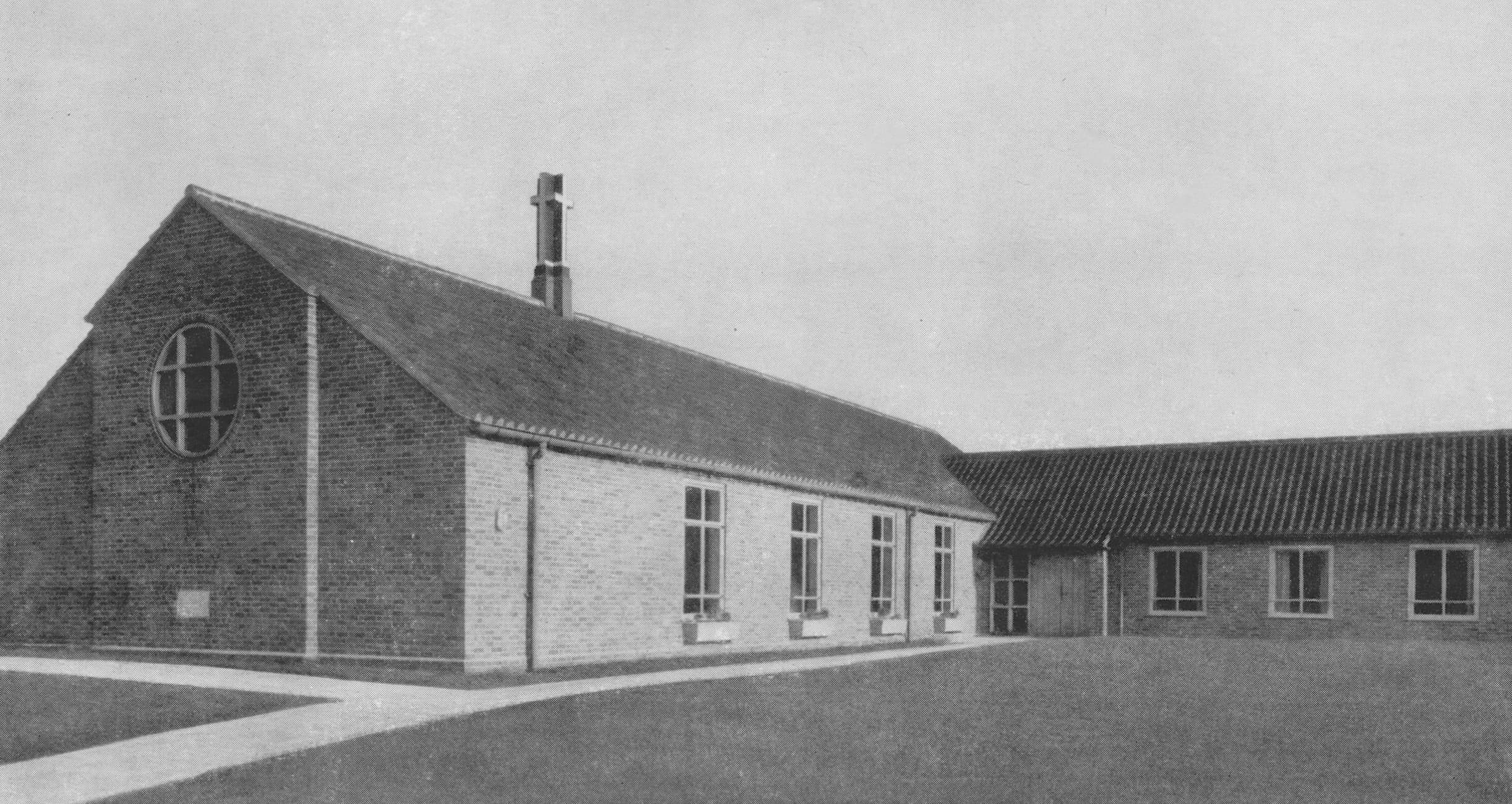
The original “hall-church”is now used as the church hall.
By 1952, services were taking place in a hut or “tin tabernacle” erected on the current site on Rushet Road. John Sertin commented on worship in the hut, “The struggle to maintain dignity, reverence and good order within the four walls of the Hut imposed a nervous and physical strain which we shall not soon forget.”
n 1953, work started on the hall, or hall-church as it was often described, since it was to be a multi-purpose building with folding screens allowing the sanctuary area to be divided off from whatever activities might take place in the body of the hall. This building is now our church hall.
In April 1959, John Sertin left, to go on to St Cuthbert’s, Wood Green. In the 9 years he had spent here he had done an enormously important work, seeing both spiritual growth and the development of the hall/church.
A couple of years later, in 1961, his successor John Tanburn wrote:- “John Sertin was the first minister, and he did a heroic work from 1951-59. In those early days the Estate was far rougher even than it is now. He started with services in his own Council house, then builders’ huts, etc., – and laid small but very solid foundations for the building up of the church.” Today we can echo those words of appreciation, and give thanks to God for the way the work here had begun.
1959-1967: John Tanburn – home meetings and erecting the church building
John Tanburn came as vicar in July 1959. As he settled into the Vicarage John Tanburn asked the PCC for help with the state of the Vicarage garden which was very rough and dangerous for children – money was offered for re-turfing. From this it is evident that the physical conditions around were still very basic and crude.
In July 1961, proposals for the new church were unveiled. The design is very similar in many ways to what was in fact built, but the most obvious difference is that the entrance path leads straight from the road into the church. This design was changed later, so that entry would be into a narthex before going on into the church – the hope was that this would mean that noisy greetings could take place in the narthex, not in the actual worship area, a hope that has perhaps been about 70% successful!
The proposals stress that the design started with the ground-plan – evaluating what a church building is for, what different features were needed, and how those features should relate together at ground level. This approach was absolutely fundamental in giving us the very usable interior that we have today.
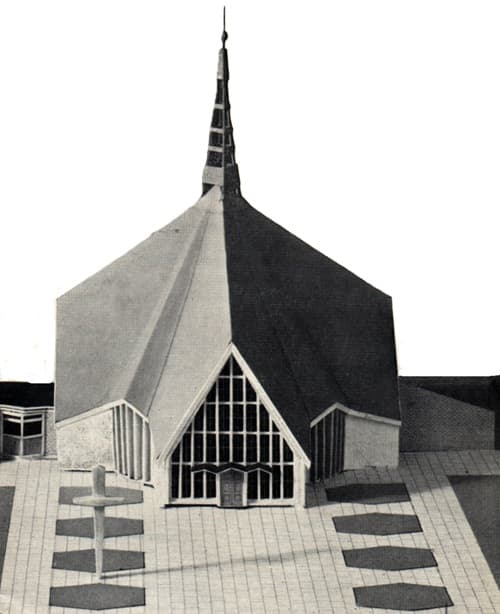
A model of the proposed church building, 1961
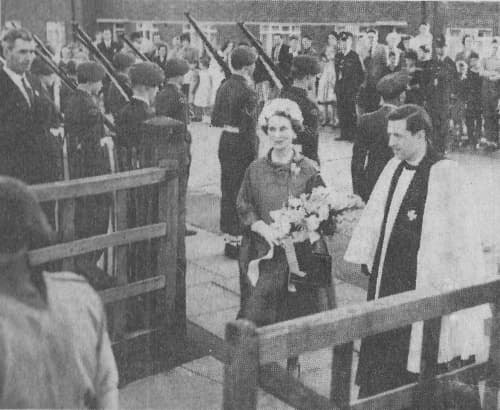
John Tanburn welcomes the Duchess of Gloucester, 8th July 1962
However, presenting plans is one thing, seeing them implemented is another, and there were many frustrating delays throughout this period. The foundation stone was laid on 8 July 1962 by the Duchess of Gloucester, but delays soon started, and in fact little work was done for the rest of year, largely because of confusion over the likely cost.
If the laying of the foundation stone was seen as a physical milestone in the life of the church, a spiritual milestone was the start in October of nine area Home Meetings. The parish was subdivided into nine smaller sub-parishes, each centred on the home of a member of the church. They were encouraged to visit the homes in their area, so that the Home Meeting was not just a cosy group of Christians but had a real evangelistic thrust.
Leadership of the groups was mainly lay. The aim was that the groups should grow and subdivide, and that in the course of time they should develop into house churches that would eventually run their own children’s groups.
This was a truly radical vision for developing house churches and was virtually a new idea for any Church of England parish. It was given wider currency by the book “Open House” that John Tanburn wrote a few years later, describing what had been done here at St Barnabas.
Today, we still have home meetings, with a very high proportion of church members belonging to them. They are not, however, organized on a geographical basis and so lack one of the main features of John Tanburn’s house churches. They do not have the evangelistic thrust that his groups had, but they may be more effective in terms of fellowship and support between members due to them meeting weekly or fortnightly, rather than monthly. Clearly there is room here for further thought about the function of groups in the life of the church.
1964: Consecration of the church building
In 1964, the building was at long, long last completed. Rowland Appleton, the Secretary of St Barnabas Builders, summed up the position early that year when he wrote one of the regular Bulletins sent out to all the supporters:
“The Secretary of St. Barnabas Builders visited the site a week or two ago and was thrilled to see what progress had been made. Externally the church looked almost complete. How different from that cold and windy January morning in 1951 when he first set foot on the site. There was not a building there, but now there stands the almost complete church, the large permanent hall, the original temporary hall, the vicarage and the curate’s and woman worker’s flats. The Lord has indeed been good to us.”
During the summer the hut, which had served for so many years, was at last pulled down. Then on September 10th came the great day, as following more than two years of building work the church was consecrated by the Bishop of Rochester, David Say, in an atmosphere of thanksgiving to God and joy at what had been done since the original vision of Canon Guy King and the St Barnabas Builders in 1951.
Historical video footage covering the building of the church has been transferred from film to digital media by Andy Fordham and uploaded to YouTube, you may like to view it here:
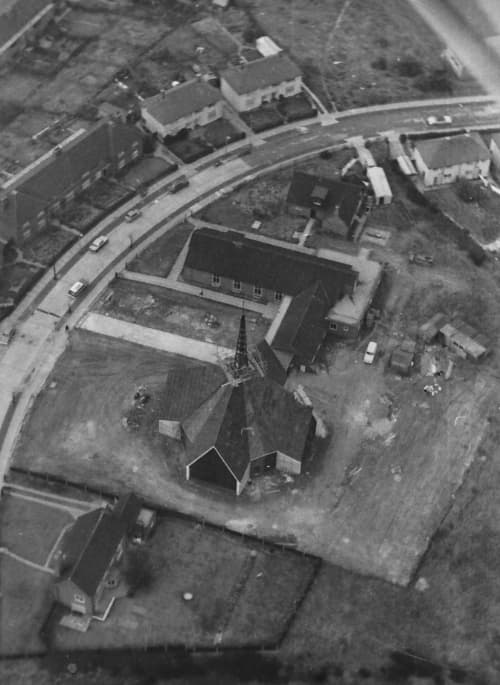
An aerial view of the church as it nears completion, 1963/63
However, John Tanburn and the other church leaders were quite clear that the building was not there for its own sake, but to be a means of witness to Jesus; this was no time for sitting around marvelling at the new facilities, and so the consecration was immediately followed up by a parish mission, the “Summit Mission”, led by Maurice Wood. Some years later it was said of this event, “For many it meant the beginning of a new life in Christ, it also marked a turning point in the life of the church, which has led to advance in many directions.”
So much had been achieved, but God’s work is never easy, and though the building was in many ways a great asset, it also posed some considerable problems. For a start, the architect had been sacked by the diocese without any consultation with the parish just before the consecration! Then came the discovery that the roof leaked badly. The leaking roof is still with us, and has become such a feature of the building that we now almost routinely put buckets out whenever it looks like rain.
1967-1975: Ron Hargreaves – the church grows
Ron Hargreaves began his ministry at St Barnabas in October 1967. He made his mark – he had a charismatic personality and came across very strongly, both in the pulpit and in writing.
This was a period of considerable growth: the electoral roll increased from 126 in 1967 to 192 in 1969, and by 1974 the roll had reached an all-time high of 401. Other indications of the strength of the church at this point are that there were 60 distributors for the magazine, and 70 volunteers were asked for in order to help with the Christian Aid Week door-to-door collection.
Growing links were appearing with other churches by this stage, and during 1970 the Orpington Council of Churches started.
On the financial side, in April there was still £12,602 owing on the church, plus £2,250 on the hall, still a very large sum of money. St Barnabas Builders would continue to give help, but most would fall on the members of the church. It was felt that the goal should be to pay off the debt in 10 years, with the church raising £1,000 per year.
However, in 1972 the PCC decided to pay off the debts by the tenth anniversary of the church’s consecration. This was a huge step of faith, but it led to an immediate increase in giving to St Barnabas Builders and the goal was in fact achieved. At a special thanksgiving service on 10th September 1974 the last cheques were handed over – glory to God! We must record with thanks the enormous amount of help received from St Barnabas Builders and all the churches that contributed to the raising of the money.
An interesting item of PCC business in 1975 was a straw vote on the ordination of women – the idea was turned down!
In 1975, Ron Hargreaves moved on to become vicar of Egham. With hindsight, we can see that one question that faced the church was this: after the very strongly focussed days of getting the buildings erected and paid for, and after the very charismatic personality of Ron Hargreaves, would the level of commitment remain, or would some people drift away? The memory of those who were in St Barnabas through the next period suggests there was indeed some drift, but that also faithful, loving Christian ministry continued to yield its fruits.
1975-1985: David Boyes – a time of consolidation and adjustment
David was a very different leader to Ron Hargreaves, being much less of a charismatic type of personality, but his ministry was to take the church forward in a number of important ways.
During his time here he had to face a large number of frustrating problems. However, in spite of such struggles, David faithfully persevered and so left much fruit from a ministry that was deeply appreciated by many people.
What perhaps he gave above all was a deep pastoral care, particularly to the many wounded people in the congregation, and so he built into the life of the church an ability to love people in all their human fragility, and an ability to cope with great upsets and hurts.
He worked hard too to develop a growing sense of being a Christian community, and he continued the process of moving the church forward into more modern patterns of worship, with a fuller recognition of the role of lay people in worship.
This was, however, a period when church-going was in general decline, aggravated here because a number of key people in St Barnabas moved away during this period. Certainly the numbers attending services dropped during David’s first years to something closer to the numbers we have today.
There were also problems within the congregation which David worked at tackling, but which he also at times found very dispiriting – for example, in the November 1981 LINK magazine he wrote of the sickness of individualism and the need to be more united in thought and action, but “the discipline of obedience necessary for such action has proved too costly for many and as a result we limp forward only slowly. … Despair threatens to defeat me – but that would be disastrous.”
In 1979, the PCC discussed the possibility of women helping to administer communion, but it was felt this would be “controversial”. It was only accepted in 1981, and even in 1983 some people were said to be opposed. Today it seems so normal that it is hard to imagine why it should have been such an issue only a few years ago.
On Easter Day, 1985, David Boyes left to become Vicar of Earl Soham and two other villages. He said “I’ve seen St Barnabas become more trusting, more free and flexible and more ready to accept responsibility for the work God has called us to do.” But he also spoke of the problem of those who held back from involvement with the church or with God.
A long interregnum then followed until George Day’s arrival in March 1986.
1986-2005: George Day – taking the story forward
1987 saw the introduction of a Thanksgiving and Blessing Service for children as a first step for those asking about baptism. It certainly hasn’t solved the problem of parents who ask for their child to be baptised but who have little grasp of what Christian faith is about. However, it has proved helpful for a number of people in different ways, and for the children of church members it is lovely to be able to have a Thanksgiving the very first Sunday the new baby is brought to church, sometimes when only a few days old.
In autumn 1988 the physical appearance of the church changed quite abruptly – the original spire had become badly corroded and needed to be replaced. Unfortunately the architects made many mistakes, and the first attempt at fitting the new spire was a total failure because the mountings on the spire did not match up with the mountings on the roof. Eventually this was corrected, and the spire was erected late in 1990.
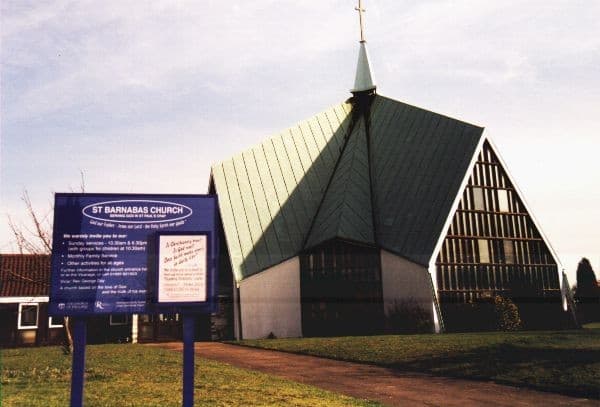
St Barnabas’ Church, 2004
The outstanding event of 1989 was the “Who Cares?” mission led by Daniel Cozens, returning to the parish some 15 years after his time as curate here. Although only short, just 4 days, the mission made a major impact. There was a great deal of contact with people outside the church, and some were converted. However, the greatest impact was within the church, with many people finding their faith revitalised or deep hurts healed. There was a huge boost to the homegroups, with the numbers attending rising to about 80, and this proved to be a long-lasting effect.One thing that resulted from the mission was that the Music Group started taking a much more prominent part, no longer leading the music in morning services from the gallery at the back, but leading from the front of the church. This, together with growth in confidence and ability, and better amplification, has meant an increasingly capable and strong lead for the music side of the worship, with the great joy that the group is equally at home with classical hymns and with modern worship songs.
In June 1989 an extremely important event took place – the first meeting of what was to become Churches Together in the Crays. Most of the local churches are involved, and warm links have been established between the churches and also between many individual members. There has been a growing sense of partnership in the Gospel, and this is undoubtedly one of the most significant developments of recent years.
Another major development has been in the area of women’s ministry. In May 1995, Jane Rawling was ordained priest and presided at Holy Communion for the first time in June, and in 1996 Serena Willoughby became the first married woman member of staff. When she was ordained priest a year later she became the first full-time woman priest on the staff. Serena and her husband, John, both made a very important contribution over the next three years, particularly in the work with young people.
In June 1999, St Barnabas was involved with other churches in the Crays and in Petts Wood in Walk Kent. We were assisted by a tremendous team of men, and working with them was a great privilege, but it has to be said that the results were very limited. However, it did continue to foster the sense of the local churches working together.
During the summer of 1999, a bid by Bromley and Bexley Boroughs for Single Regeneration Budget money was accepted, which made large amounts of money available for development and regeneration in the Cray Valley area. To work with this, a Community Forum was set up to cover the Crays and Ramsden, with a very high representation from the local churches on this Forum. Not all the results were as great as had been hoped, but one very significant advance for the local community was the start of The Centre in Cotmandene Crescent, and most of the local churches have had a very strong involvement with this.
In 2001 for the first time a Christmas pageant was held, with a nativity procession, including a donkey, from the church down to Cotmandene Crescent, where the outside of one of the shops had been artistically converted into the stable. Carol singing followed. This has been repeated each year since then, although sadly the donkey was no longer available in 2004!
In 2002 a Fun Day was held in the church and the church grounds in celebration of the Queen’s Golden Jubilee, and in conjunction with various other groups. Another similar very successful Fun Day was held in 2004 in association with the celebrations in Rochester Diocese of the 1400th anniversary.
During summer 2003 the area at the back of the church hall was completely revamped, providing a wheelchair accessible toilet and refurbished men’s and women’s toilets. In a second stage in summer 2004 extra storage space was created, partly for the Pre-school, but also for the various other groups that use the hall and need various amounts of equipment. This has made a huge difference particularly for the pre-school staff, and has meant the clutter has now gone from the corridors. In summer 2005, the hall and lounge windows were replaced – just think, no more painting of metal windows at church work-parties!
In June 2005, George Day left St Barnabas after 19 years, to become Vicar of St Barnabas, Joydens Wood. After a vacancy of one year, in June 2006, St Barnabas was pleased to welcome its first woman incumbent, Alyson Davie.
Going forward with God – questions for the future
The story of St Barnabas from its beginnings is a great story of God blessing and leading us. Now we look to the future with faith in his continuing blessing and guidance. As we do so, there are several important questions we must face about how we should adapt to changing circumstances.
1. How do we win people for Christ today?
2. How do we staff the work of the church?
3. How do we respond to the social needs of the area?
4. How do we deal with the problem of the church roof and stewardship of our resources?
These are four big questions, and some of their implications for the future can seem quite demanding and threatening. Nevertheless, the church remains very positive about meeting the challenges ahead.
